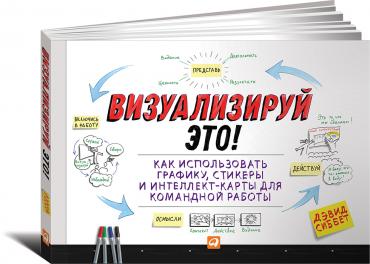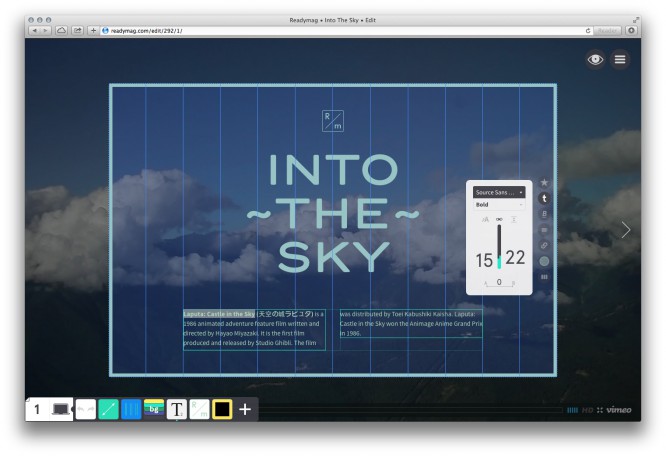David Sibbet “Visualize It!”
David Sibbet “Visualize It!”
 Do you know who Dan Roham is? Yes, yes, the one who wrote a series of books on how to express your ideas on paper: simple drawings, arrows, lines, circles and stuff like that. So, David Sibbet is a colleague of Dan Roham, they do the same thing: they visualize ideas on paper using simple drawings.
Do you know who Dan Roham is? Yes, yes, the one who wrote a series of books on how to express your ideas on paper: simple drawings, arrows, lines, circles and stuff like that. So, David Sibbet is a colleague of Dan Roham, they do the same thing: they visualize ideas on paper using simple drawings.
On the one hand, if you’ve read Dan Roham’s books before, you’re likely to think, “Why would I read the same thing if both authors write about the same thing?” But on the other hand, isn’t it interesting to look at the same problem from several angles? This is exactly what I did after reading the book “Visualize It!” David Sibbet.
What is this book about
In addition to the fact that the author talks about how to visualize his ideas on paper, he also gives practical advice on how to do it in a team (for comparison, Dan Roham only gave examples of his teamwork, but never described this process and did not give recommendations).
Overall, after reading Visualize It! I got the impression that these are 2 Roehm’s books put together: “The Practice of Visual Thinking” + “Visual Thinking”. Partly because both of these books are part of the same idea that all people can visualize their ideas on paper, which Roham is actively promoting.
“Visualize it!” integrates information from the books mentioned above, and also expands the area of ”visualization” of their ideas far beyond the paper sheet. For example, David suggests using toy figures, cards with pictures, and indeed any objects from the world around us to make visual accents, while telling something to the interlocutor.
Who is this book for
Perhaps I will note that the audience for this book is slightly wider than that of Dan Roeme’s books: designers and managers who often have to communicate with many people and convey their thoughts to them in an understandable way. The audience grew in part because David went beyond just visualizing ideas on paper. As I mentioned earlier, he expanded the scope of the book to include the practice of giving presentations created during the lectures themselves in front of the audience.

Practice speaking without a projector
David Sibbet is not only a Visualization theorist, but also a practitioner. He is often invited to take “visual notes” at meetings and conferences so that participants can clearly see the results, conduct various seminars, and also train novice lecturers in the ability to convey the meaning of a speech to the public without a prepared presentation and a projector.
On the one hand, speaking without a projector is more difficult, but on the other, it is more interesting and understandable for the audience. After all, when there is no projector, it is replaced either by a chalk board or large sheets of paper on which the speaker notes the material. The author gives a huge number of advice precisely on the topic of such speeches: how to properly organize seating places so that everyone can see the lecturer, how to write information so that it fits all and is not too small, how not to get confused in your own notes, etc. … In general, If you have long wanted to try this format of performance, be sure to read Chapter 13 Series of Encounters and Galley Walks.
Real life examples
I got the impression that in his book David Sibbet devotes much moreaboutmore attention to examples from his practice than his colleague Dan Roehem. Perhaps because Sibbet took part in work with large companies, whose names are customary to be proud of: Apple, Avon, Virgin and others. He talks about some of the listed companies in great detail, because as a result of the “visual” training that he conducted, the audience subsequently achieved great results.
About the book format
Likewise with Roehm’s books (as well as all other books whose format does not fit into the proportions of A4 paper), the book “Visualize this!” absolutely impossible to hold in your hands. If you can somehow cope with the square books of Roehm, then you cannot cope with the rectangular book of Sibbet, what can we say about reading it in transport, holding a canopy. You can read the book only at the table, there are no other ways.
Outcome
The book “Visualize It!” I would advise you to read if you have not read Roehm’s books before, or if you plan to implement “visual” team work on a project: when everyone expresses their thoughts graphically, others perceive them better, and the summary of the meeting always remains for future work.
Download
The first few dozen pages of Visualize It! available for viewing completely free of charge.
Buy
The book is available for purchase at the Ozon store.
…


